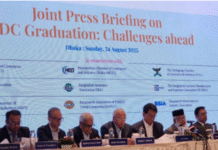In his address to a seminar on “National Strategy for Prevention of Money Laundering and Combating Financing of Terrorism 2019-2021” in November 2019, Finance Minister Mustafa Kamal said that it is not only that money laundering “creates macroeconomic distortion”, but it is “largely destroying our country in various ways”. Those were some strong words. And if we look at the data, in the context of Bangladesh, using strong words to describe the curse of money laundering is necessary.
A number of reports released by Global Financial Integrity (GFI) in recent times have pinpointed Bangladesh as being among the worst affected countries to the scourge of trade-based money laundering (TBML). According to GFI’s President Raymond Baker, “Illicit financial flows are the most damaging economic problems faced by the world’s developing and emerging economies.” This means we are among the countries worst plagued by one of the biggest problems (among all the problems) out there that developing countries are having to deal with.
According to GFI, USD 61.6 billion were siphoned out of Bangladesh between 2005 and 2014, which is equivalent to 25 percent of its GDP in FY 2016-17. Between 2008 and 2017, Bangladesh lost a staggering USD 7.53 billion per year on average to trade misinvoicing, which accounted for 17.95 percent of Bangladesh’s international trade with all its trading partners during the period.
In a more recent report, GFI revealed that USD 5.9 billion was siphoned out of Bangladesh through trade misinvoicing in 2015—and that Bangladesh is one of the top 30 countries in terms of illicit financial flows.
Similarly, Transparency International Bangladesh (TIB) reported this year that some USD 3.1 billion or Tk 26,400 crore is being illegally remitted from Bangladesh every year. Though it is lower in comparison to the GFI’s estimates between 2008 and 2017, even this amount would have deprived the government exchequer of about Tk 120 billion as revenue each year, which is significant.
Yet, according to Dr Iftekharuzzaman, Executive Director of Transparency International Bangladesh, money laundering still enjoys impunity in Bangladesh. In a recent article for The Daily Star, he wrote: “Any crime is bound to flourish when laws and regulations are not enforced and violators are not held accountable. This is exactly what has been happening with money laundering in Bangladesh.” Though there has been a decrease in total deposits by Bangladeshis in Swiss banks, as recently revealed by the Swiss Banking authorities, Dr Iftekharuzzaman highlighted that it was more likely due to money launderers preferring other destinations, rather than the amount of money being laundered from Bangladesh actually decreasing.
Only recently, the Nikkei Asian Review did a story on how the Directorate General of Health Services quoted prices paid for procurement of medical personnel safety goggles at USD 59 a pair, which is almost five times more than its market rate. Other purchases of medical gowns, software, website development and audiovisual clips under an emergency coronavirus project were similarly excessively billed.
Similarly, grain imports from Canada jumped up from USD 438 million in 2018 to USD 1.08 billion in 2019, according to Statistics Canada, representing a 128.31 percent rise. But according to the Bangladesh Bank’s statistics, the country-wise import payments for grain do not match with the Canadian figures. According to the BB, import payments to Canada in the fiscal year 2017-18 stood at around USD 500 million only. Therefore, it is quite likely that at least some part of that huge discrepancy occurred due to money laundering.
As the finance minister himself said, money laundering causes various economic problems. According to one senior BB official quoted by an English daily, one such problem came in the form of the price of the US dollar seeing an upward trend in Bangladesh earlier in the year, when its price was actually declining in the international market. In the words of the official, “The price of the dollar has increased against the taka because of a rise in money laundering… The Bangladeshi currency is being sent to Malaysia, Singapore, Australia, and Canada.”
Years ago, India used to top the charts of GFI reports. However, after WikiLeaks disclosed its massive offshore banking problem, and following significant criticism of the government’s failure to address it, policy reforms in the country along with an annual automatic exchange of banking information with Switzerland—letting India access information on bank accounts held by Indian citizens in that country—led to nearly a 50 percent drop in Indian deposits in Swiss banks over a one-year period. There is no question that launderers probably found other ways to launder their money. But by increasing their cost of laundering money, the Indian government did disincentivise money laundering to some extent.
Meanwhile, our government has decided that it will once again provide people the opportunity to whiten black money during the budget announcement. This, according to experts, incentivises money laundering. Besides that, lack of regulatory monitoring and supervision of financial activities of individuals and enterprises is allowing criminals to hide their actual financial reports. And in the absence of proper coordination between agencies (domestic and international), preventing financial crime becomes even more difficult.
Sadly, Bangladesh meets almost all the requirements necessary to make it a perfect victim of largescale money laundering—including the fact that its government’s policies have fallen far short of disincentivising money laundering and have, in fact, facilitated it at times. That has mostly happened because, as Dr Iftekharuzzaman wrote, the perpetrators of the crime have usually been “tied to the power structure” and hence have often “determined the terms” that have allowed them to get away with it.
Eresh Omar Jamal is a member of the editorial team at The Daily Star.










